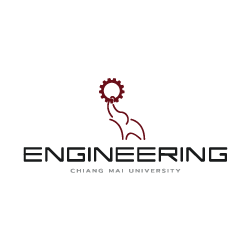ข้อมูลสำหรับผู้แต่ง
| ระยะเวลาเสนอขอตีพิมพ์บทความ | ||
| (ดาวน์โหลดแบบฟอร์มการพิมพ์บทความด้านล่างของหน้านี้) | อย่างน้อย 4 สัปดาห์ (1 เดือน) |
1. ผู้เขียนส่งบทความไฟล์ Microsoft Word (นามสกุล .docx) ที่จัดรูปแบบการพิมพ์ตามแบบฟอร์มของวารสารฯ
• การจัดรูปแบบไฟล์ Word ตามเอกสารด้านล่างเพจนี้
• ขอให้ใช้ฟอนต์ Th Sarabun New สำหรับข้อความภาษาไทยและอังกฤษ
• สำหรับสมการ ขอให้สร้างด้วย Microsoft Equation
เรียบร้อยแล้ว ส่งบทความผ่านระบบออนไลน์ที่นี่
* ในการส่งบทความเพื่อลงตีพิมพ์ กรุณาระบุ ชื่อ นามสกุลของผู้เขียน รหัสนักศึกษา สังกัดภาควิชา อาจารย์ที่ปรึกษา ที่อยู่ที่ติดต่อได้ เบอร์โทรศัพท์ และ E-mail แนบมาด้วย *
2. เจ้าหน้าที่ตรวจสอบความถูกต้องของบทความ หากบทความไม่สมบูรณ์ มีรูปแบบการพิมพ์ไม่ถูกต้อง จะแจ้งเพื่อให้ผู้เขียนแก้ไขบทความ (ระยะเวลาในการตรวจสอบบทความไม่เกิน 3 วันทำการ)
3. เจ้าหน้าที่แจ้งบรรณาธิการพิจารณาบทความและพิจารณา Reviewer อย่างน้อย 2 ท่าน (กำหนดระยะเวลาพิจารณา 2 สัปดาห์)
4. เจ้าหน้าที่ส่งบทความให้ Reviewer อ่านและพิจารณา (กำหนดระยะเวลาอ่านท่านละ 2 สัปดาห์)
5. Reviewer แจ้งผลการพิจารณามายัง กองบรรณาธิการฯ เพื่อเสนอผลการพิจารณาให้บรรณาธิการรับทราบ โดยผลการพิจารณามีดังต่อไปนี้
[ ] ยอมรับการตีพิมพ์บทความ (ตีพิมพ์ โดยไม่มีการแก้ไข)
[ ] ขอให้มีการแก้ไข (ตีพิมพ์โดยแก้ไขเล็กน้อยตามข้อเสนอแนะ)
[ ] ส่งใหม่เพื่อประเมินอีกครั้ง (แก้ไขและส่งกลับให้ Reviewer พิจารณาใหม่)
[ ] ส่งไปยังวารสารอื่น/ปฏิเสธการรับตีพิมพ์บทความ (ไม่ยอมรับ)
6. หาก Reviewer ให้ แก้ไขและส่งกลับให้ Reviewer พิจารณาใหม่ กองบรรณาธิการฯ จะแจ้งไปยังอาจารย์ที่ปรึกษา (อาจารย์ที่ปรึกษาต้องแจ้งให้ผู้เขียนทราบเพื่อทำการแก้ไข) หรือผู้เขียนโดยตรง โดยมีเวลาให้ผู้เขียนแก้ไขบทความเป็นเวลา 2 สัปดาห์ จากนั้นส่งกลับมายังระบบวารสารฯ เพื่อส่งให้ Reviewer พิจารณาอีกครั้ง
7. หาก Reviewer ให้ ตีพิมพ์โดยแก้ไขเล็กน้อยตามข้อเสนอแนะ ผู้เขียนต้องทำการแก้ไขบทความตามที่ Reviewer เสนอ โดยใช้ไฟล์ที่จัดรูปแบบการพิมพ์แล้ว เเละจัดทำรายละเอียดการเเก้ไขบทความ (ตามเเบบฟอร์มของวารสารฯ) จากนั้นส่งกลับมายังระบบวารสารฯ เพื่อส่งให้ Reviewer พิจารณาอีกครั้ง หากไม่มีข้อแก้ไขหรือข้อเสนอแนะเพิ่มเติม กองบรรณาธิการฯ จะออกเอกสารตอบรับตีพิมพ์บทความให้ผ่านระบบออนไลน์
8. หาก Reviewer ให้ ตีพิมพ์ โดยไม่มีการแก้ไข กองบรรณาธิการฯ จะออกเอกสารตอบรับตีพิมพ์ แจ้งไปยังอาจารย์ที่ปรึกษา หรือผู้เขียน ผ่านระบบออนไลน์
หมายเหตุ : วารสารวิศวกรรมศาสตร์ มหาวิทยาลัยเชียงใหม่ เปิดรับบทความวิชาการในสาขาวิศวกรรมศาสตร์จากผู้สนใจตลอดปี
ดาวน์โหลดเอกสาร
- แบบฟอร์มรูปแบบ (Template)


- แบบตัวหนังสือ (Font)

- ขั้นตอนการขอตีพิมพ์บทความลงวารสารวิศวกรรมศาสตร์ และการจัดหน้ากระดาษ

- ผังขั้นตอนการขอตีพิมพ์บทความฯ (Flow Chart)

- แบบฟอร์มรายละเอียดการแก้ไขบทความ




